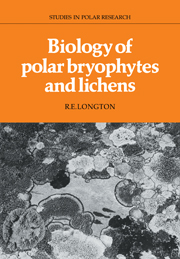Book contents
- Frontmatter
- Contents
- Preface
- 1 The polar regions
- 2 The cryptogamic vegetation
- 3 Pattern, process and environment
- 4 Radiation and microclimate
- 5 Physiological processes and response to stress
- 6 Vegetative growth
- 7 Cryptogams in polar ecosystems
- 8 Reproductive biology and evolution
- References
- Index of generic and specific names
- Subject index
3 - Pattern, process and environment
Published online by Cambridge University Press: 24 April 2010
- Frontmatter
- Contents
- Preface
- 1 The polar regions
- 2 The cryptogamic vegetation
- 3 Pattern, process and environment
- 4 Radiation and microclimate
- 5 Physiological processes and response to stress
- 6 Vegetative growth
- 7 Cryptogams in polar ecosystems
- 8 Reproductive biology and evolution
- References
- Index of generic and specific names
- Subject index
Summary
Environmental relationships of polar cryptogamic vegetation
Evidence concerning environmental control over the distribution of polar bryophytes and lichens is largely circumstantial as it is derived principally from observed correlations between vegetation and environment, which do not necessarily imply direct control by the factors concerned. Moreover, distribution is influenced by complex combinations of climatic and other variables so that correlations may be difficult to elucidate.
Ordination provides a means of alleviating the latter difficulty, as demonstrated by Webber's (1978) study of Alaskan tundra. Webber showed that species richness among both bryophytes and lichens is highest under mesic to dry conditions with moderate soil phosphate levels, but that species richness for lichens shows a stronger correlation with good soil aeration than does that for mosses (Fig. 3.1). Different patterns were shown by species indices based on frequency and cover (Fig. 3.2), which reveal that bryophytes are most abundant under relatively wet conditions with poor soil aeration and low phosphate, whereas lichen abundance is greatest on drier, well aerated soils with moderate phosphate.
The analysis also provided valuable insight into the habitat preferences of individual species, but such techniques have not been widely applied to polar vegetation. In some instances, however, relationships between plant distribution and environment stand out so clearly that a controlling influence for the factors concerned may reasonably be inferred from simple observation. Other evidence comes from physiological studies, as discussed in Chapters 5 and 6.
- Type
- Chapter
- Information
- Biology of Polar Bryophytes and Lichens , pp. 66 - 105Publisher: Cambridge University PressPrint publication year: 1988
- 2
- Cited by



